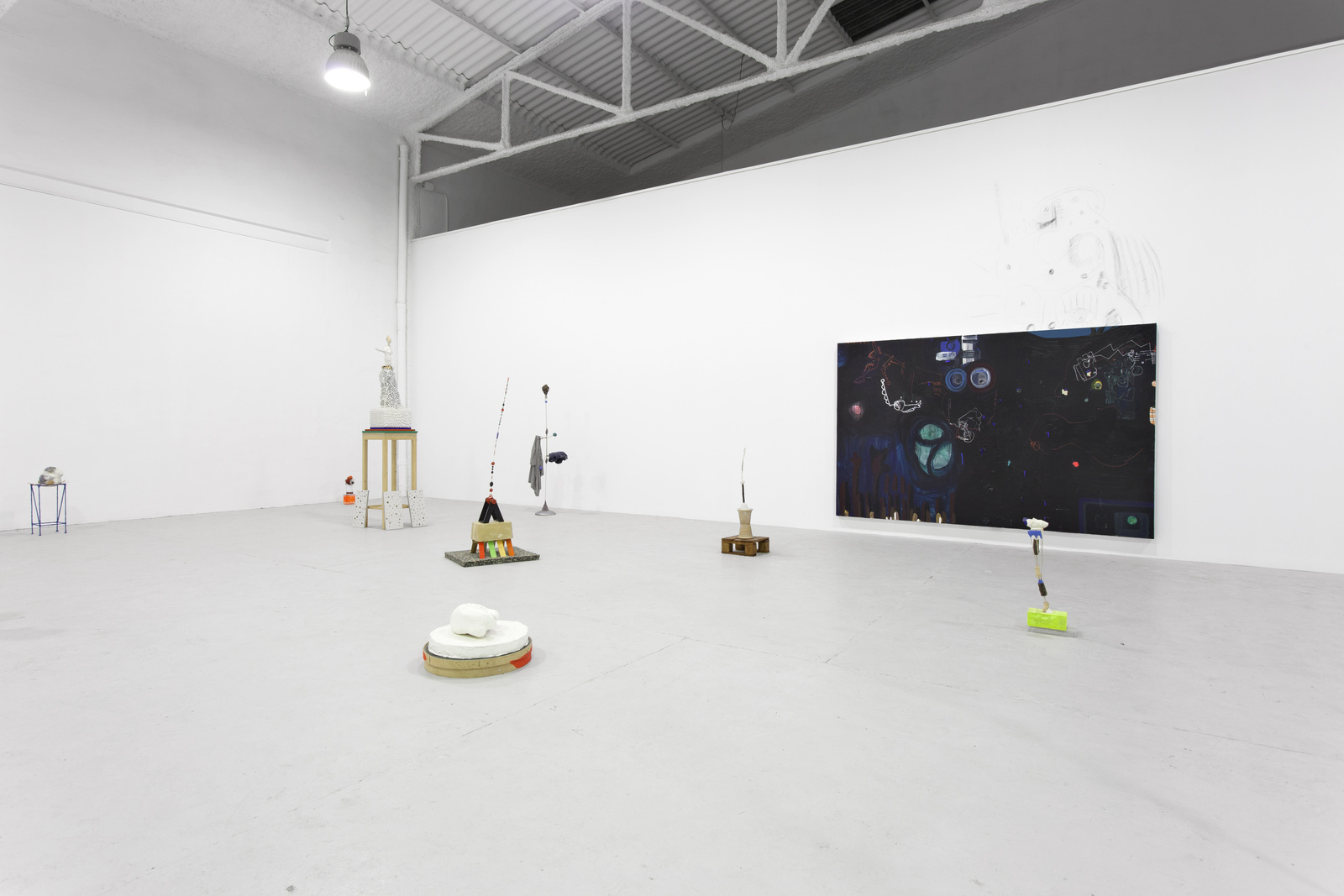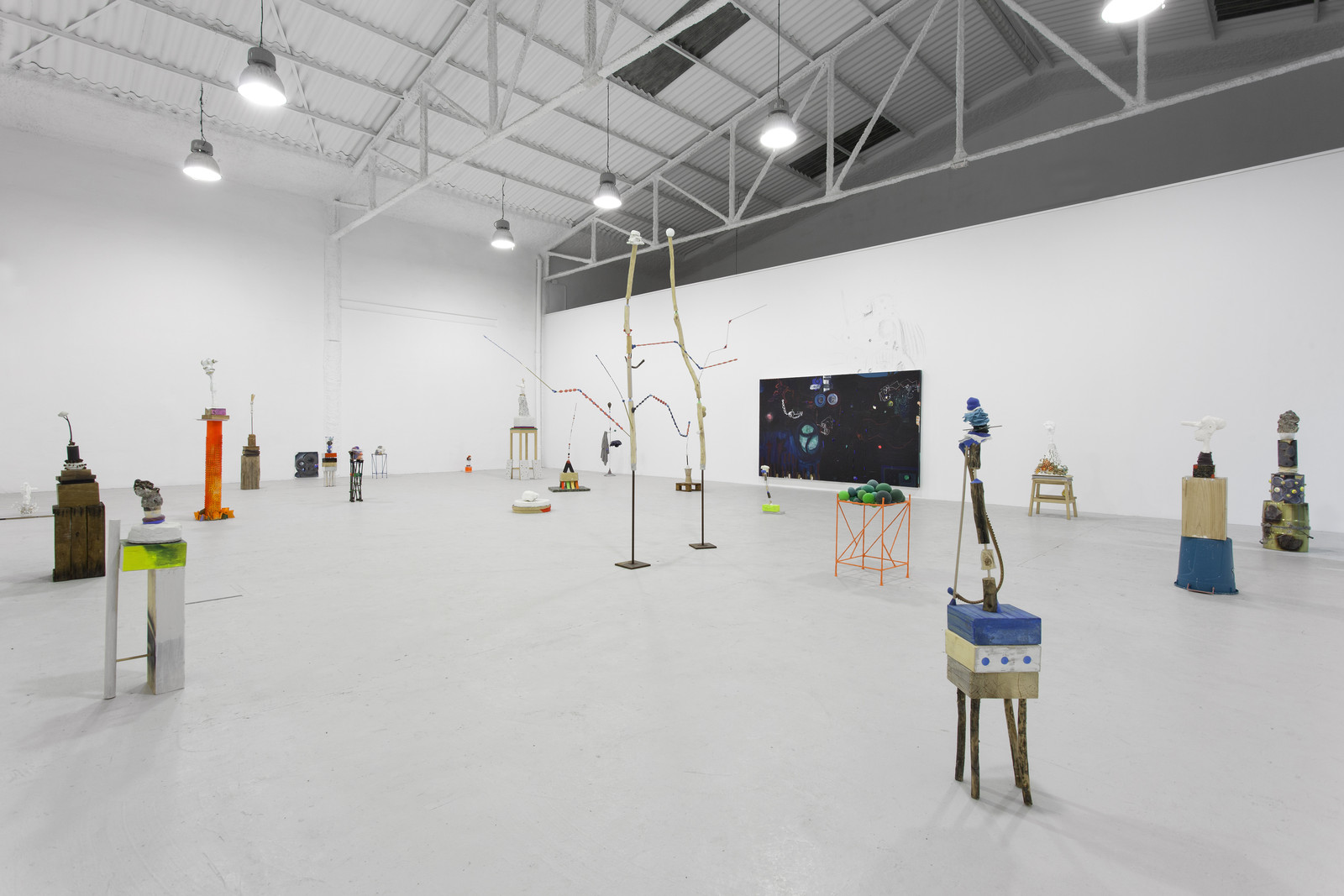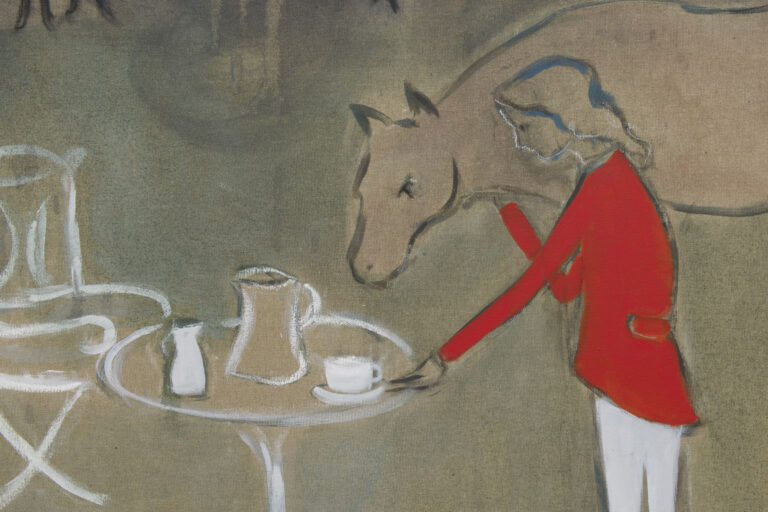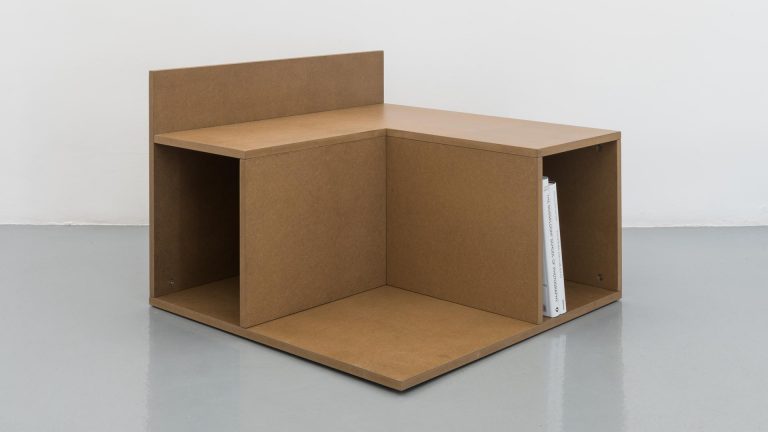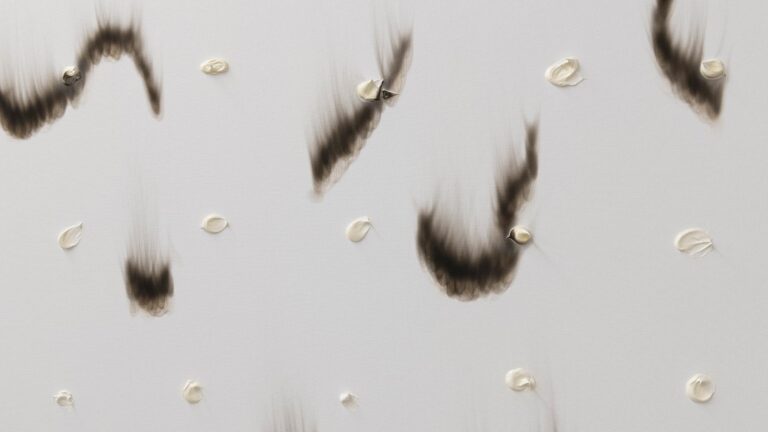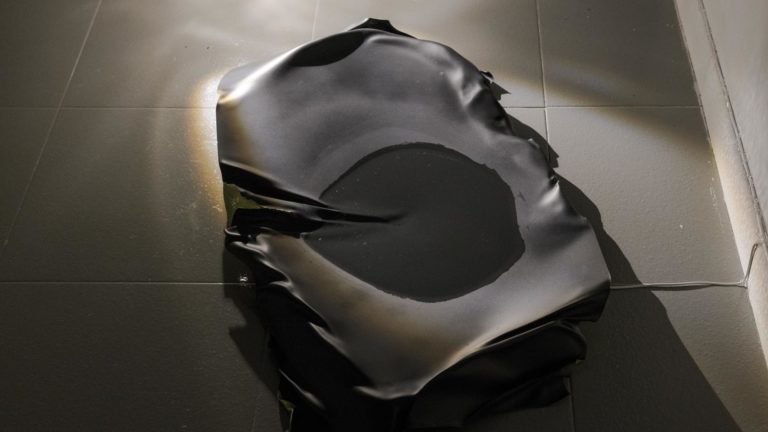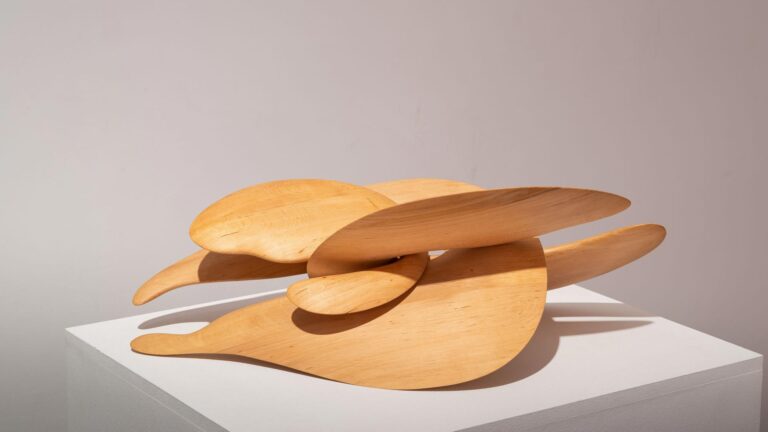Artist: Rafa Forteza
Exhibition title: Cuando el pie encontró su cabeza (When the foot found its head)
Venue: L21 Gallery, Mallorca, Spain
Date: June 28 – September 7, 2017
Photography: Natasha Lebedeva and John Forest, all images copyright and courtesy of the artist and L21 Gallery, Mallorca
“I like complications because it gives the sensation that you’re not deciding anything. That the spectator feels I’m not getting anywhere and everything comes from the suggestion. To me, that is being honest.’’
-Rafa Forteza[1]
Lose your head, lose your footing. Synonyms for an altered state provoked by the absence, the nullification of an element inside the unity of a body. The foot symbolizes the physical part of the body and is the point of contact with the earth, upon which it sustains all of its weight in balance. The head, conversely, is in contact with the air, it’s the image of rationality, thought, and imagination. They evoke independent functions, that require support from one another, for instance, each foot requires a head to stimulate its movement, and each head needs a foot to avoid falling. Rafa Forteza’s work is based on the pursuit of this indissociable union between the foot and the head through the composition and accumulation of elements of said union, a union between fragments of different order that create complex bodies, in a constructive process that is activated in each new piece.
His sculptures are assemblies of a diversity of elements that intertwine in vertical structures in a state of apparent instability, defiant of the logics of physics, that react with vibrations and tremors when visitors pass by. Built under the principle of the accumulation of elements, in them we find all kinds of components: elements that have been carefully selected from nature based on their material qualities are joined by others industrially made. It’s not about finding mere random, duchampian objects, with Forteza, everything must go through a period of coexistence in his study after which it goes through a transformation by the adhesion or extraction of materials, folding, cutting or the application of paint. Without a base or pedestal, each element is deposited one over the other, finding its place and function in the structure, until an autonomous unit is created with its own foot and head; a final structure determined and unequivocal, that could nevertheless come into contradiction in a later move. He works on several sculptures at once, combining its different constitutive elements and provoking changes that can affect each other, in an essay of infinite compositions teeming with the organic and natural, of contagion; like the very same appearance of the sculptures. Among them, stand out a series of dehumanized faces with exacerbated features that seem to interrogate the viewer with their large noses and their open cavities in form of eyes and mouths. They talk to us about the senses, of the importance of perceiving in a work of art characterized by the visual and tactile provocation of the spectator, who can touch some elements, weigh them, feel their lightness or even change their place to create a new order.
His pictorial work is also based in the relation between multiple and diverse abstract elements with which to elaborate innumerable combinations that take to the limit the possibilities of composition, rhythm, and an ample chromatism that goes from the deepest blacks to the phosphorescence. Over plain backgrounds, he succeeds in creating a false sensation of reality; the illusion of a space through the addition of elements and the superposition of layers and layers of paint. Geometric forms and circular stains, combined with great dexterity through soft but determined strokes, of great gestuality, come to meet us. Papers and added objects create reliefs as a way to transform the painting into something more, leaving the bidimensionality that characterizes it in stricto senso. The pictorial surface is formed by decentered fragments, that generate a rhythm full of equilibriums and tensions, weights and vibrations, over which our gaze navigates in an attempt to decipher a reality that does not exist. In them it becomes obvious that “in the representation that is a work of art, the idea is not that the work of art represents something that it’s not; the art piece is not, in no sense an allegory, that is, it doesn’t say something so something else may be thought, but rather that only and precisely itself can find what it needs to say”[2].
To reunite, to meet in the same place, to create relations, interact and connect. Unlike the term ‘to group up’ which is more indeterminate, in the reunion exists a causal relation between the integrating elements that join each other with a common purpose. A series of pieces made in the last few years have reunited in the gallery, taking them from the piling in the workshop and placing them in an ample and transparent place where new relations are made and the sculptures fuse with the paintings in symbiosis. In the assembly process, each piece has found its place in the building, organically and without previous planning; taking his creative process, where no sketches are made, to the room. The ensemble creates an installation that wishes to escape any summaries, as with all his work, in a nearly anarchic manner. His pieces generate an awe-inspiring, enveloping reality, synesthesia, through compositions, colors and materials that evoke visual, tactile and auditive sensations that take us for a moment to the artist’s workshop: a refuge where years of artistic experience are accumulated, along the books of artists, literature, poetry and music that nurtures his work. It sounds like John Coltrane’s jazz, with his interminable solos that take us to another place, and we understand a bit better the ascendant movement, nearly transcendental in his sculptures, the decomposition and fragmentation of the shapes in his paintings, his ability to make use travel to a state between reality and irreality. The exercise that takes place in the exhibition room tenses as well the white cube in the gallery, archetypal space in the art of the 20th century, before the fact that “we’ve made it to the point where we no longer see art, instead we chiefly see the continent”[3]. Forteza treats the space of the gallery without reverence, overflowing it, putting ahead the relation that exists between the pieces in its center and, above all, claiming the presence of the viewer with whom to communicate.
To find oneself. His work recalls from a time of its own and from true contact with the spectator, far away from the hastiness and virtuality of our current relationships. An outside of our capitalist trans-aesthetic era marked by a universe of superabundance, of aesthetic inflation, by the dominion of style and emotion as strategies that the market has adopted to captivate the desires of the ‘’hedonist neo-consumer, devoted to the commercial culture of entertainment”[4]. On the contrary, Forteza demands a slow moment of observation and reflexive will; a clash with the art piece without any more indications than coexisting with it and letting go. His work happens in the encounter with the viewer; it’s a dialog that, like in literature, produces a linguistic space that is never-ending, never has a beginning, yet happens “when it transforms in the open intimacy of someone that writes it and of someone that reads it, the space violently unfolded by the mutual confrontation of the power of saying and the power of listening”[5].
-Beatriz Escudero, Critic and curator
[1] Quote from an interview with Rafa Forteza in his studio, 29th May 2017.
[2] Hans-Georg Gadamer. The relevance of the beautiful, Paidós Ibérica (1991), p. 96.
[3] Brian O’Doherty. Inside the white cube, Centro de Documentación y Estudios Avanzados de Arte Contemporáneo (CENDEAC), p. 20.
[4] Gilles Lipovetsky and Jean Seroy. The aestheticization of the world. Living in an age of artistic capitalism.. Editorial Anagrama (2015), p. 23
[5] Maurice Blanchot. El espacio literario. Paidos Iberica (1992), p. 31.
Rafa Forteza, born in 1955 in Mallorca, Spain. He’s had solo exhibitions in galleries and museums like L21, Kewenig Mallorca, Pelaires, Joan Miró Foundation, The State Russian Museum in Saint Petersburg, Kunst Station Sankt Peter in Cologne among many others, and more recently at Es Baluard Contemporary Art Museum in Mallorca. His work is part of collections like MoMA New York, Centro Nacional de Arte Reina Sofia Madrid, Centre Pompidou Paris, Collection DeutscheBank, La Caixa Collection, Münchner Kunstlerhaus Stiftung Munich… He has published artists books next to many poets and artists like Joan Brossa, José Carlos Llop, José Ángel Valente, Antonio Saura, and many others. This year, a monograph of his work “Más cara” was published by editions & publications (Spain).
Rafa Forteza, Cuando el pie encontró su cabeza, 2017, exhibition view, L21 Gallery, Mallorca
Rafa Forteza, Cuando el pie encontró su cabeza, 2017, exhibition view, L21 Gallery, Mallorca
Rafa Forteza, CUANDO EL PIE ENCONTRÓ SU CABEZA 42, 2017, Wire, rusty can, plastic, scourer, foam, enamel and spray paint on framed canvas, 267×160 cm
Rafa Forteza, CUANDO EL PIE ENCONTRÓ SU CABEZA 39, 2015, Oil on panel, 24x18cm
Rafa Forteza, CUANDO EL PIE ENCONTRÓ SU CABEZA 32, 2015, Oil on panel, 24x18cm
Rafa Forteza, CUANDO EL PIE ENCONTRÓ SU CABEZA 33, 2015, Oil on panel, 24x18cm
Rafa Forteza, Cuando el pie encontró su cabeza, 2017, exhibition view, L21 Gallery, Mallorca
Rafa Forteza, CUANDO EL PIE ENCONTRÓ SU CABEZA 25,1995, Wood, oil, pencils and epoxy resin, 26x13x8cm
Rafa Forteza, CUANDO EL PIE ENCONTRÓ SU CABEZA 26, 2017, Aluminium pots, wood, paper plaster, acrylic resin, acrylic paint and concrete, 126x30x30cm
Rafa Forteza, Cuando el pie encontró su cabeza, 2017, exhibition view, L21 Gallery, Mallorca
Rafa Forteza, Cuando el pie encontró su cabeza, 2017, exhibition view, L21 Gallery, Mallorca
Rafa Forteza, Cuando el pie encontró su cabeza, 2017, exhibition view, L21 Gallery, Mallorca
Rafa Forteza, Cuando el pie encontró su cabeza, 2017, exhibition view, L21 Gallery, Mallorca
Rafa Forteza, Cuando el pie encontró su cabeza, 2017, exhibition view, L21 Gallery, Mallorca
Rafa Forteza, Cuando el pie encontró su cabeza, 2017, exhibition view, L21 Gallery, Mallorca
Rafa Forteza, Cuando el pie encontró su cabeza, 2017, exhibition view, L21 Gallery, Mallorca
Rafa Forteza, Cuando el pie encontró su cabeza, 2017, exhibition view, L21 Gallery, Mallorca
Rafa Forteza, Cuando el pie encontró su cabeza, 2017, exhibition view, L21 Gallery, Mallorca
Rafa Forteza, CUANDO EL PIE ENCONTRÓ SU CABEZA 15,1995-2017, Bronze, wood, nails, acrylic plaster and ceramic flower pots, 94x30x30cm
Rafa Forteza, CUANDO EL PIE ENCONTRÓ SU CABEZA 16, 2017, Acrylic resin, acrylic paint, dried seaweed and oil on linen, 180x300x10cm; PARAKEET, 2017, Charcoal on wall, Variable dimensions
Rafa Forteza, CUANDO EL PIE ENCONTRÓ SU CABEZA 19, 2017, Collage, acrylic resin, acrylic painting, vinyl, oil and aluminium sheet on linen, 180x300x10cm; CUANDO EL PIE ENCONTRÓ SU CABEZA 18, 1995-2017, Wood, nails, felt and bronze, 120x35x27cm
Rafa Forteza, Cuando el pie encontró su cabeza, 2017, exhibition view, L21 Gallery, Mallorca
Rafa Forteza, Cuando el pie encontró su cabeza, 2017, exhibition view, L21 Gallery, Mallorca
Rafa Forteza, Cuando el pie encontró su cabeza, 2017, exhibition view, L21 Gallery, Mallorca
Rafa Forteza, Cuando el pie encontró su cabeza, 2017, exhibition view, L21 Gallery, Mallorca
Rafa Forteza, CUANDO EL PIE ENCONTRÓ SU CABEZA 50, 2015, Oil on panel, 40×40; CUANDO EL PIE ENCONTRÓ SU CABEZA 22, 2017, Wood, leather, acrylic resin and acrylic paint, 120x25x20cm
Rafa Forteza, CUANDO EL PIE ENCONTRÓ SU CABEZA 50, 2015, Oil on panel, 40×40
Rafa Forteza, CUANDO EL PIE ENCONTRÓ SU CABEZA 13, 2015-2017, Cardboard, plastic, wood, dried seaweed, acrylic resin, acrylic paint and acrylic plaster, 190x40x34cm
Rafa Forteza, CUANDO EL PIE ENCONTRÓ SU CABEZA 12, 2016, Aluminium, acrylic resin, acrylic paint, rubber bands, dried seaweed and plastic pot, 80x18x18cm
Rafa Forteza, Cuando el pie encontró su cabeza, 2017, exhibition view, L21 Gallery, Mallorca
Rafa Forteza, Cuando el pie encontró su cabeza, 2017, exhibition view, L21 Gallery, Mallorca
Rafa Forteza, Cuando el pie encontró su cabeza, 2017, exhibition view, L21 Gallery, Mallorca
Rafa Forteza, CUANDO EL PIE ENCONTRÓ SU CABEZA 24, 2011-2017, Plastic cube, acustic foam, wood, acrylic resin and acrylic paint, 120x26x34cm
Rafa Forteza, CUANDO EL PIE ENCONTRÓ SU CABEZA 08, 2015-2017, Wood, acrylic paint, acrylic resin, epoxy resin and used clothes, 210x41x41
Rafa Forteza, CUANDO EL PIE ENCONTRÓ SU CABEZA 09, 2017, Aluminium, acrylic resin, wood, metal and used clothes, 163x50x30cm
Rafa Forteza, CUANDO EL PIE ENCONTRÓ SU CABEZA 23, 2016, Wood, dried seaweed, acrylic resin and acrylic paint, 74x37x37cm
Rafa Forteza, Cuando el pie encontró su cabeza, 2017, exhibition view, L21 Gallery, Mallorca
Rafa Forteza, Cuando el pie encontró su cabeza, 2017, exhibition view, L21 Gallery, Mallorca
Rafa Forteza, CUANDO EL PIE ENCONTRÓ SU CABEZA 05, 2000, Wood, felt, iron, cord, wire and candles, 164x23x20cm; CUANDO EL PIE ENCONTRÓ SU CABEZA 02, 2017, Wood, acrylic resin and dried seaweed, 90x20x18cm
Rafa Forteza, CUANDO EL PIE ENCONTRÓ SU CABEZA 12, 2016, Aluminium, acrylic resin, acrylic paint, rubber bands, dried seaweed and plastic pot, 80x18x18cm
Rafa Forteza, Cuando el pie encontró su cabeza, 2017, exhibition view, L21 Gallery, Mallorca
Rafa Forteza, CUANDO EL PIE ENCONTRÓ SU CABEZA 14, 2014, Wood, metallic mesh strainer, acrylic resin, acrylic paint and epoxy resin, 27x46x46cm
Rafa Forteza, Cuando el pie encontró su cabeza, 2017, exhibition view, L21 Gallery, Mallorca
















